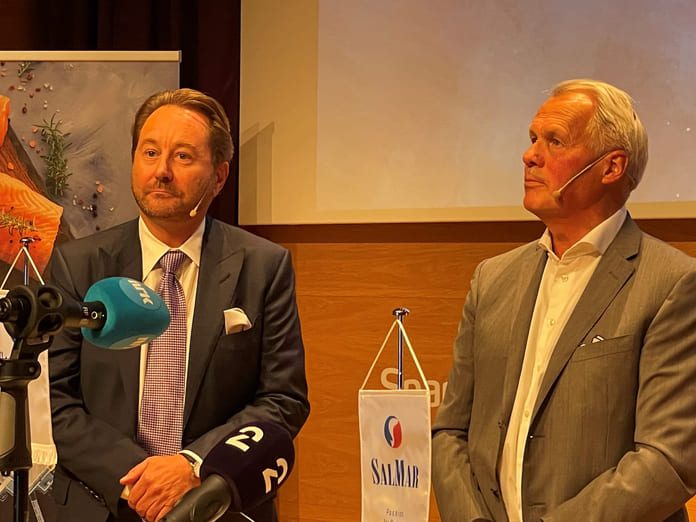New strategic alliance between Aker and SalMar in offshore farming.
“At SalMar we will be the market leader in the development of coastal farming and farming in the open sea,” said Gustav Witzøe.
“I remember when we started in 1991. Our main aim was to ensure year-round employment with local processing – to keep the lights on,” said Witzøe and added that the harvest volume in the start-up year was 400 tonnes of salmon.
There is an extensive media presence in the premises of Sparebank1 SMN in Trondheim, Norway. Witzøe notes that the takeover bid for Norwegian Royal Salmon (NRS) is motivated by both companies’ investment in offshore farming.
The salmon is the boss
“SalMar is founded on the salmon’s health. It is a fact that good biology provides good economics. The salmon is the boss. Ever since the start, we have been looking for the best areas for salmon farming. In 2012, we took the first steps exploring the possibilities of farming salmon at sea – in the salmon’s natural habitat.”
The farming business has been tested on the ocean rig “Ocean Farm 1”. The experiences so far are good growth, low mortality and no lice infestation.
“We saw that we needed a strategic partner to secure the necessary expertise. So I called Kjell Inge Røkke. I met amazing enthusiasm from day one. He wanted to come to Frøya the very next day.”
Together, they have established SalMar Aker Ocean, which “will be at the very forefront of the development of sea-based farming”. The investment will be the start of an industrial adventure, the partners believe.
Joint venture
Øyvind Eriksen leads the 180-year-old industrial company.
“I have been head of Aker for 13 years. We have always talked about being established in all the leading industries in Norway, but not in salmon farming,” he said, adding that Aker has designed over 60 per cent of all floating production units in the world.
The new joint venture company started with ownership of “Ocean Farm 1”, with an annual production volume of 6,300 tonnes of salmon per year. SalMar owns two thirds, Aker with one third, but we will work with the basic attitude that we are equal partners.
“We will immediately start designing a third rig, perhaps with an investment decision next spring,” said Eriksen.
“We have an ambition of 150,000 tonnes by 2030,” said Gustav Witzøe.

Simple reason
When asked why Aker has not invested in salmon before, main shareholder Kjell Inge Røkke answered.
“There is a simple reason. I did not believe in it. But I am dumbfounded with admiration for what Gustav and others have achieved. It is an industry that has changed, become an important industry with rapid technological development.”
However, Aker and Røkke were on the owner’s side of a leading salmon farming company 22 years ago. In the spring of 1999, Aker’s subsidiary Norway Seafoods owned 35 per cent of the fast-growing fish farming company Norway Seafarms. With an annual production of 20,000 tonnes of salmon, in Norway and the Faroe Islands, the company was among Norway’s largest.
Over the spring and summer, the price of salmon increased rapidly. Then minority shareholder Pan Fish submitted a bid for the company. The settlement was 90 per cent in shares in the Ålesund company that had gone like a shot on the stock exchange. Aker said yes, and sold out of the aquaculture industry.
Wrong
Røkke would rather focus on cod, pollock and haddock. Not salmon.
“I am a fisherman by heart and education. And in the mid-90s, I thought whitefish was an important sector for us. I did an analysis. I thought the [salmon] industry would face opposition. Supermarkets would not allow super profits. That was one of my reservations. I was wrong.”
Aker has also tried its hand at salmon later, via development licenses.
“We stopped by salmon, together with NRS. We applied for licenses, but did not get enough licenses, so we withdrew.”
“It is solely my fault that Aker has not been in salmon,” said Røkke and held both hands up.
30,000 tonnes of structural steel
“For us; to become a shareholder together with Gustav, where we feel we have a lot to contribute. These are semi-rigs, and we have, as previously mentioned, designed 60 per cent of all floating rigs in the world. When the opportunity arose, I was not so difficult. But Gustav is a tough dealer, so we ended up a minority shareholder,” Røkke chuckled.
“It is probably good day for us,” he said.
“If you look at Smart Fish Farm, there are just under 30,000 tonnes of structural steel. And there are no rigs that have had so much steel in them,” said Røkke.
“When we get to those rigs, Kjell Inge and I will travel to Seattle. There are many other places where you can put these rigs,” Witzøe added.
“We absolutely see potential for farming outside Norway,” said SalMar’s chairman Leif Inge Nordhammer.

